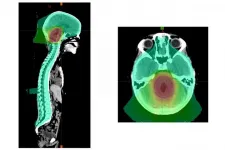(Press-News.org) Astronomers from University of Warwick and University of Exeter modelling the future of unusual planetary system found a solar system of planets that will 'pinball' off one another
Today, the system consists of four massive planets locked in a perfect rhythm
Study shows that this perfect rhythm is likely to hold for 3 billion years - but the death of its sun will cause a chain reaction and set the interplanetary pinball game in motion
Four planets locked in a perfect rhythm around a nearby star are destined to be pinballed around their solar system when their sun eventually dies, according to a study led by the University of Warwick that peers into its future.
Astronomers have modelled how the change in gravitational forces in the system as a result of the star becoming a white dwarf will cause its planets to fly loose from their orbits and bounce off each other's gravity, like balls bouncing off a bumper in a game of pinball.
In the process, they will knock nearby debris into their dying sun, offering scientists new insight into how the white dwarfs with polluted atmospheres that we see today originally evolved. The conclusions by astronomers from the University of Warwick and the University of Exeter are published in the Monthly Notices of the Royal Astronomical Society.
The HR 8799 system is 135 light years away and comprises a 30-40 million year-old A type star and four unusually massive planets, all over five times the mass of Jupiter, orbiting very close to each other. The system also contains two debris discs, inside the orbit of the innermost planet and another outside the outermost. Recent research has shown that the four planets are locked in a perfect rhythm that sees each one completing double the orbit of its neighbour: so for every orbit the furthest completes, the next closest completes two, the next completes four, while the closest completes eight.
The team from Warwick and Exeter decided to learn the ultimate fate of the system by creating a model that allowed them to play 'planetary pinball' with the planets, investigating what may cause the perfect rhythm to destabilise.
They determined that the resonance that locks the four planets is likely to hold firm for the next 3 billion years, despite the effects of Galactic tides and close flybys of other stars. However, it always breaks once the star enters the phase in which it becomes a red giant, when it will expand to several hundred times its current size and eject nearly half its mass, ending up as a white dwarf.
The planets will then start to pinball and become a highly chaotic system where their movements become very uncertain. Even changing a planet's position by a centimetre at the start of the process can dramatically change the outcome.
Lead author Dr Dimitri Veras from the University of Warwick Department of Physics said: "The planets will gravitationally scatter off of one another. In one case, the innermost planet could be ejected from the system. Or, in another case, the third planet may be ejected. Or the second and fourth planets could switch positions. Any combination is possible just with little tweaks.
"They are so big and so close to each other the only thing that's keeping them in this perfect rhythm right now is the locations of their orbits. All four are connected in this chain. As soon as the star loses mass their locations will deviate, then two of them will scatter off one another, causing a chain reaction amongst all four."
Dr Veras was supported by an Ernest Rutherford Fellowship from the Science and Technology Facilities Council, part of UK Research and Innovation.
Regardless of the precise movements of the planets, one thing that the team is certain of is that the planets will move around enough to dislodge material from the system's debris discs into the atmosphere of the star. It is this type of debris that astronomers are analysing today to discover the histories of other white dwarf systems.
Dr Veras adds: "These planets move around the white dwarf at different locations and can easily kick whatever debris is still there into the white dwarf, polluting it.
"The HR 8799 planetary system represents a foretaste of the polluted white dwarf systems that we see today. It's a demonstration of the value of computing the fates of planetary systems, rather than just looking at their formation."
Co-author Professor Sasha Hinkley of the University of Exeter said: "The HR 8799 system has been so iconic for exoplanetary science since its discovery nearly 13 years ago, and so it is fascinating to see into the future, and watch it evolve from a harmonious collection of planets into a chaotic scene."
INFORMATION:
* 'The post-main-sequence fate of the HR 8799 planetary system' is published in Monthly Notices of the Royal Astronomical Society, DOI: 10.1093/mnras/stab1311 Link: https://doi.org/10.1093/mnras/stab1311
Notes to editors:
Artist's impression of the four planets of the HR 8799 system and its star (Credit: University of Warwick/Mark Garlick). Image is free for use if used in direct connection with this story but image copyright and credit must be University of Warwick/Mark Garlick:
https://warwick.ac.uk/services/communications/medialibrary/images/junes_2021/hr_8799.jpg
The European Southern Observatory have a pre-existing video showing the orbital motion of the HR8799 system. The video is available for media use via the link below, but it must be accompanied by the credit: J. Wang et al. - https://www.eso.org/public/videos/eso1905b/
For interviews or a copy of the paper contact:
Peter Thorley
Media Relations Manager (Warwick Medical School and Department of Physics) | Press & Media Relations | University of Warwick
Email: peter.thorley@warwick.ac.uk
Mob: +44 (0) 7824 540863
The Science and Technology Facilities Council (STFC)
The Science and Technology Facilities Council (STFC) is part of UK Research and Innovation - the UK body which works in partnership with universities, research organisations, businesses, charities, and government to create the best possible environment for research and innovation to flourish. For more information visit UK Research and Innovation.
STFC funds and supports research in particle and nuclear physics, astronomy, gravitational research and astrophysics, and space science and also operates a network of five national laboratories, including the Rutherford Appleton Laboratory and the Daresbury Laboratory, as well as supporting UK research at a number of international research facilities including CERN, FERMILAB, the ESO telescopes in Chile and many more. Visit https://stfc.ukri.org/ for more information. @STFC_Matters
When is a weed not a weed?
Can native plants be weeds?
Sweet pittosporum (Pittosporum undulatum) was once a well-behaved tree growing in gullies from Gippsland in Victoria up to Brisbane in Queensland.
But it is now a major problem, leading to an almost complete suppression of native vegetation where it has invaded. Programs to clear it have successfully allowed indigenous plants to return, and within 15 years, with moderate follow up, treated sites are well on the way to successful restoration.
However, there has been some debate on whether this is good or bad for birds such as the threatened Powerful Owl.
New research by Monash University scientists from the School of Biological Sciences published today in Ecological Solutions and ...
Astronomers have spotted a giant 'blinking' star towards the centre of the Milky Way, more than 25,000 light years away.
An international team of astronomers observed the star, VVV-WIT-08, decreasing in brightness by a factor of 30, so that it nearly disappeared from the sky. While many stars change in brightness because they pulsate or are eclipsed by another star in a binary system, it's exceptionally rare for a star to become fainter over a period of several months and then brighten again.
The researchers believe that VVV-WIT-08 may belong to a new class of 'blinking giant' binary star system, where a giant star ? 100 times larger ...
Oncotarget published "The presence of polymorphisms in genes controlling neurotransmitter metabolism and disease prognosis in patients with prostate cancer: a possible link with schizophrenia" reported that polymorphisms of neurotransmitter metabolism genes were studied in patients with prostate cancer (PC) characterized by either reduced or extended serum prostate-specific antigen doubling time corresponding to unfavorable and favorable disease prognosis respectively.
The following gene polymorphisms known to be associated with neuropsychiatric disorders were investigated:
A. The STin2 VNTR in the serotonin transporter SLC6A4 gene;
B. The 30-bp VNTR in the monoamine oxidase A MAOA gene;
C. The Val158Met polymorphism in the catechol-ortho-methyltransferase ...
Scientists at Tokyo Institute of Technology (Tokyo Tech) and NEC Corporation jointly develop a 28-GHz phased-array transceiver that supports efficient and reliable 5G communications. The proposed transceiver outperforms previous designs in various regards by adapting fast beam switching and leakage cancellation mechanism.
With the recent emergence of innovative technologies, such as the Internet of Things, smart cities, autonomous vehicles, and smart mobility, our world is on the brink of a new age. This stimulates the use of millimeter-wave bands, which have far more signal bandwidth, to accommodate these new ideas. 5G can offer data ...
Medulloblastoma is a rare but devastating childhood brain cancer. This cancer can spread through the spinal fluid and be deposited elsewhere in the brain or spine. Radiation therapy to the whole brain and spine followed by an extra radiation dose to the back of the brain prevents this spread and has been the standard of care. However, the radiation used to treat such tumors takes a toll on the brain, damaging cognitive function, especially in younger patients whose brains are just beginning to develop.
A national study led by Washington University School of Medicine in St. Louis and St. Jude Children's Research Hospital suggests that children with what is called "average risk medulloblastoma" can receive a radiation "boost" to a smaller ...
Metformin is a widely prescribed blood sugar-lowering drug. It is often used as an early therapy (in combination with diet and lifestyle changes) for type 2 diabetes, which afflicts more than 34 million Americans.
Metformin works by lowering glucose production in the liver, reducing blood sugar levels that, in turn, improve the body's response to insulin. But scientists have also noted that metformin possesses anti-inflammatory properties, though the basis for this activity was not known.
In a study published online June 8, 2021 in the journal END ...
Married men who don't help out around the house tend to bring home bigger paychecks than husbands who play a bigger role on the domestic chores front.
New research from the University of Notre Dame shows that "disagreeable" men in opposite-sex marriages are less helpful with domestic work, allowing them to devote greater resources to their jobs, which results in higher pay.
In contemporary psychology, "agreeableness" is one of the "Big Five" dimensions used to describe human personality. It generally refers to someone who is warm, sympathetic, kind and cooperative. Disagreeable people do not tend to exhibit these characteristics, and they tend to ...
An estimated 8 million tons of plastic trash enters the ocean each year, and most of it is battered by sun and waves into microplastics--tiny flecks that can ride currents hundreds or thousands of miles from their point of entry.
The debris can harm sea life and marine ecosystems, and it's extremely difficult to track and clean up.
Now, University of Michigan researchers have developed a new way to spot ocean microplastics across the globe and track them over time, providing a day-by-day timeline of where they enter the water, how they move and where they tend to collect.
The approach relies on ...
Have you ever been cut off in traffic by another driver, leaving you still seething miles later? Or been interrupted by a colleague in a meeting, and found yourself replaying the event in your head even after you've left work for the day? Minor rude events like this happen frequently, and you may be surprised by the magnitude of the effects they have on our decision-making and functioning. In fact, recent research co-authored by management professor Trevor Foulk at the University of Maryland's Robert H. Smith School of Business suggests that in certain situations, incidental rudeness like this can be deadly.
In "Trapped ...
HOUSTON - (June 10, 2021) - Leaders who encourage their employees to learn on the job and speak up with ideas and suggestions for change have teams that are more effective and resilient in the face of unexpected situations, according to new research from Rice University and the University of Windsor.
"A Resource Model of Team Resilience Capacity and Learning" will appear in a special issue of Group & Organization Management. Authors Kyle Brykman, an assistant professor at the Odette School of Business at the University of Windsor, and Danielle King, an ...




